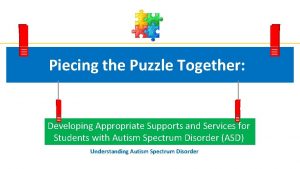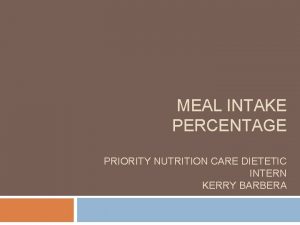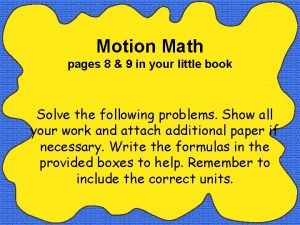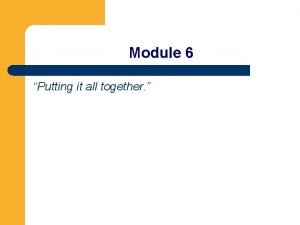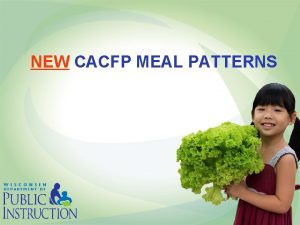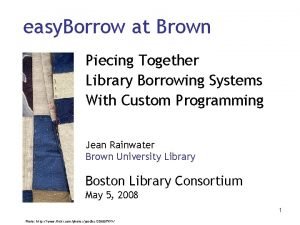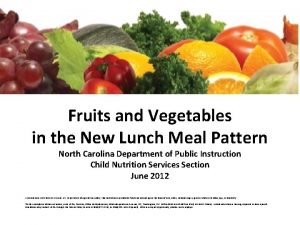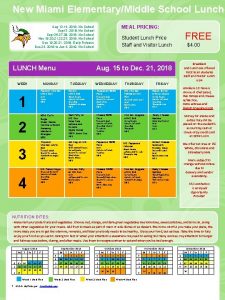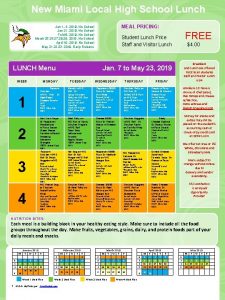Piecing It All Together The New Lunch Meal















































- Slides: 47

Piecing It All Together The New Lunch Meal Pattern 1

Five Vegetable Subgroups Dark Green Five Required Components Red/Orange Beans/Peas (Legumes) Starchy Other Meat/Meat Alternate Healthy, Fruit Hunger-Free Vegetable Whole Grain-Rich Foods Milk Kids Act Grain SY 2012 -13, SY 2013 -14: At least Only fat-free or low-fat varieties Milk half must be whole grain-rich Fat-free flavored or unflavored Low-fat unflavored SY 2014 -15 and beyond: All grains must be whole-grain rich 2

2012 -2013 New Lunch Meal Pattern Dietary Specifications at Lunch 2013 -2014 New Breakfast Meal Pattern Dietary Specifications at Breakfast 3 Year Administrative Review Cycle Implementation Phases 2014 -2015 Future All Grains = Whole Grain-Rich 2017 -2018 Sodium Target #2 Sodium Target #1 2022 -2023 Sodium Target #3 3

Components of a Reimbursable Meal Meat/Meat Alternate Fruits Vegetables Grains Milk 4

Meat/Meat Alternate—Lunch Grades K-5 Grades 6 -8 Grades K-8 Grades 9 -12 8 -10 ounces weekly 9 -10 ounces weekly 10 -12 ounces weekly 1 ounce daily minimum 2 ounces daily minimum • For the 2012 -13 and 2013 -14 SY, menus must meet daily and weekly minimums. • Menus must still meet calorie ranges for each grade grouping. • For the 2014 -15 SY and beyond, menus must meet daily and weekly minimums and maximums. 5

Meat/Meat Alternate—Lunch Grades K-5 Grades 6 -8 Grades K-8 Grades 9 -12 8 -10 ounces weekly 9 -10 ounces weekly 10 -12 ounces weekly 1 ounce daily minimum 2 ounces daily minimum 1 ounce of beef, fish, or poultry* = 1 ounce of Meat/Meat Alternate *cooked, skinless, unbreaded 6

Meat/Meat Alternate—Lunch Grades K-5 Grades 6 -8 Grades K-8 Grades 9 -12 8 -10 ounces weekly 9 -10 ounces weekly 10 -12 ounces weekly 1 ounce daily minimum 2 ounces daily minimum 4 ounces (weight) or ½ cup (volume) of dairy or soy yogurt = 1 ounce of Meat/Meat Alternate • May be plain or flavored, sweetened or unsweetened • Not creditable: frozen yogurt, drinkable yogurt, homemade yogurt, yogurt flavored or covered products, and yogurt bars 7

Meat/Meat Alternate—Lunch Grades K-5 Grades 6 -8 Grades K-8 Grades 9 -12 8 -10 ounces weekly 9 -10 ounces weekly 10 -12 ounces weekly 1 ounce daily minimum 2 ounces daily minimum 2. 2 ounces (by weight) of commercially prepared tofu* = 1 ounce of Meat/Meat Alternate * Must also have 5 or more grams of protein 8

Meat/Meat Alternate—Lunch Grades K-5 Grades 6 -8 Grades K-8 Grades 9 -12 8 -10 ounces weekly 9 -10 ounces weekly 10 -12 ounces weekly 1 ounce daily minimum 2 ounces daily minimum 2 tablespoons of nut butter = 1 ounce of Meat/Meat Alternate Examples: peanut butter, almond butter, cashew butter, sesame seed butter, soy nut butter, or sunflower seed butter 9

Meat/Meat Alternate—Lunch Grades K-5 Grades 6 -8 Grades K-8 Grades 9 -12 8 -10 ounces weekly 9 -10 ounces weekly 10 -12 ounces weekly 1 ounce daily minimum 2 ounces daily minimum 1 ounce (weight) of nuts/seeds = 1 ounce of Meat/Meat Alternate • Nuts or seeds may be used to meet no more than half of the Meat/Meat Alternate component. • Nuts or seeds must be paired with another Meat/Meat Alternate to meet the full requirement. Examples: peanuts, almonds, sunflower seeds, cashews 10

Meat/Meat Alternate—Lunch Grades K-5 Grades 6 -8 Grades K-8 Grades 9 -12 8 -10 ounces weekly 9 -10 ounces weekly 10 -12 ounces weekly 1 ounce daily minimum 2 ounces daily minimum • ¼ cup of cooked beans/peas (legumes) = 1 ounce of Meat/Meat Alternate. • You must serve more than ¼ cup of beans/liquid. The liquid does not count as beans. • Beans/peas can be a meat alternate or vegetable, but not both in the same meal Examples: black beans, kidney beans, garbanzo beans, or baked beans. 11

Meat/Meat Alternate—Lunch Grades K-5 Grades 6 -8 Grades K-8 Grades 9 -12 8 -10 ounces weekly 9 -10 ounces weekly 10 -12 ounces weekly 1 ounce daily minimum 2 ounces daily minimum • Other meat alternates may be used to meet all or part of the Meat/Meat Alternate component 1 large egg = 2 oz Meat/Meat Alternate 2 oz cheese = 2 oz Meat/Meat Alternate • Minimum creditable serving of Meat/Meat Alternate is 0. 25 oz 12

Fruit Component—Lunch Grades K-5 Grades 6 -8 Grades K-8 Grades 9 -12 2 ½ cups weekly 5 cups weekly ½ cup daily minimum 1 cup daily minimum • There are no maximums for the fruit component, except for juice. • The minimum creditable serving of fruit is 1/8 cup. 13

Fruit Component—Lunch Grades K-5 Grades 6 -8 Grades K-8 Grades 9 -12 2 ½ cups weekly 5 cups weekly ½ cup daily minimum 1 cup daily minimum • No more than half of the weekly fruit offering may be in the form of juice. • If juice is offered, it must be pasteurized, 100% fullstrength fruit juice. 14

Fruit Component—Lunch Grades K-5 Grades 6 -8 Grades K-8 Grades 9 -12 2 ½ cups weekly 5 cups weekly ½ cup daily minimum 1 cup daily minimum Dried fruit credits as twice the volume served. Example: ¼ cup of raisins counts as ½ cup of fruit 15

Fruit Component—Lunch Grades K-5 Grades 6 -8 Grades K-8 Grades 9 -12 2 ½ cups weekly 5 cups weekly ½ cup daily minimum 1 cup daily minimum • For SY 2012 -13 and SY 2013 -14 only, frozen fruit with added sugar is allowable. • Beginning in SY 2014 -15 and beyond, all frozen fruit must contain no added sugar. 16

Fruit Component—Lunch Grades K-5 Grades 6 -8 Grades K-8 Grades 9 -12 2 ½ cups weekly 5 cups weekly ½ cup daily minimum 1 cup daily minimum Reimbursable meals may no longer include snack-type fruit products, such as fruit snacks, drops, leathers, and strips. 17

Vegetable Component—Lunch Minimum Requirements Grades K-5 Grades 6 -8 Grades K-8 Grades 9 -12 3 ¾ cups 5 cups weekly ¾ cup per day day Vegetable Subgroups Weekly Requirements Dark Green ½ cup Red/Orange Beans/Peas (Legumes) Starchy Other Additional Vegetables to Reach Total ¾ cup ½ cup ½ cup 1 cup ¾ cup ½ cup 1 cup per day ½ cup 1 ¼ cups ½ cup ¾ cup 1 ½ cup 18

Vegetable Component—Lunch Grades K-5 Grades 6 -8 Grades K-8 Grades 9 -12 3 ¾ cups weekly 5 cups weekly ¾ cup daily minimum 1 cup daily minimum • There are no maximums for the vegetable component, except for juice. • The minimum creditable serving of vegetable is 1/8 cup. 19

Vegetable Component—Lunch Grades K-5 Grades 6 -8 Grades K-8 Grades 9 -12 3 ¾ cups weekly 5 cups weekly ¾ cup daily minimum 1 cup daily minimum • No more than half of the weekly vegetable offering may be in the form of juice. • If juice is offered, it must be pasteurized, 100% fullstrength vegetable juice. 20

Vegetable Component—Lunch Grades K-5 Grades 6 -8 Grades K-8 Grades 9 -12 3 ¾ cups weekly 5 cups weekly ¾ cup daily minimum 1 cup daily minimum Raw, dark leafy green vegetables credit as half the volume served. • Example: 1 cup of raw spinach counts as ½ cup of dark green vegetables Cooked, dark leafy green vegetables credit as the volume served • Example: ½ cup of sautéed spinach counts as ½ cup of dark green vegetables 21

Dark Green Vegetables Bok Choy Broccoli Collard greens Dark green leafy lettuce Kale Mesclun Mustard greens Romaine lettuce Spinach Turnip greens Watercress 22

Red/Orange Vegetables Acorn squash Butternut squash Carrots Hubbard squash Pumpkin Red peppers Sweet potatoes Tomato juice 23

Beans/Peas (Legumes) Black beans Black-eyed peas (mature, dry) Garbanzo beans (chickpeas) Kidney beans Lentils Navy beans Pinto beans Soy beans Split peas White beans 24

Starchy Vegetables Cassava Corn Fresh cowpeas, field peas, or black-eyed peas (not dry) Green bananas Green peas Green lima beans Plantains Potatoes Taro Water chestnuts 25

Other Vegetables Artichokes Asparagus Avocado Bean sprouts Beets Brussels sprouts Cabbage Cauliflower Celery Cucumbers Eggplant Green beans Green peppers Iceberg lettuce Mushrooms Okra Onions Turnips Wax beans Zucchini 26

Grains Component—Lunch Grades K-5 Grades 6 -8 Grades K-8 Grades 9 -12 8 -9 oz eq weekly 8 -10 oz eq weekly 8 -9 oz eq weekly 10 -12 oz eq weekly 1 per day minimum 2 per day minimum • For the 2012 -13 and 2013 -14 SY, menus must meet daily and weekly minimums. • Menus must still meet calorie ranges for each grade grouping. • For the 2014 -15 SY and beyond, menus must meet daily and weekly minimums and maximums. 27

Grains Component—Lunch Grades K-5 Grades 6 -8 Grades K-8 Grades 9 -12 8 -9 oz eq weekly 8 -10 oz eq weekly 8 -9 oz eq weekly 10 -12 oz eq weekly 1 per day minimum 2 per day minimum • For the 2012 -13 SY, there is no change in measuring the required minimum quantities for Grains • For the 2013 -14 SY and beyond, all grains must be credited using the “oz eq” method 28

Grains Component—Lunch Grades K-5 Grades 6 -8 Grades K-8 Grades 9 -12 8 -9 oz eq weekly 8 -10 oz eq weekly 8 -9 oz eq weekly 10 -12 oz eq weekly 1 per day minimum 2 per day minimum • The minimum creditable serving of grains is 0. 25 oz eq • For SY 2012 -2013 only, SFAs have flexibility to decide whether to count batter/breading greater than or equal to 0. 25 oz eq toward the daily and weekly grains requirements. 29

Grains Component—Lunch Grades K-5 Grades 6 -8 Grades K-8 Grades 9 -12 8 -9 oz eq weekly 8 -10 oz eq weekly 8 -9 oz eq weekly 10 -12 oz eq weekly 1 per day minimum 2 per day minimum • SY 2012 -13 and SY 2013 -14: At least half of the grains offered must be whole grain-rich. • SY 2014 -15 and beyond: All grains offered must be whole grain-rich. 30

Grains Component—Lunch Grades K-5 Grades 6 -8 Grades K-8 Grades 9 -12 8 -9 oz eq weekly 8 -10 oz eq weekly 8 -9 oz eq weekly 10 -12 oz eq weekly 1 per day minimum 2 per day minimum At lunch, up to 2 oz eq of grains per week may be in the form of a grain-based dessert. 31

Whole Grain-Rich Foods that contain 100% whole grain OR Foods that contain a blend of whole grain meal and/or flour and enriched meal and/or flour NOTE: Whole grain-rich products must contain at least 50% whole grain and the remaining grain must be enriched 32

Milk Component—Lunch Grades K-5 Grades 6 -8 Grades K-8 Grades 9 -12 5 cups weekly 1 cup daily • Unflavored (white) milk – only skim or 1% can be served • Flavored (e. g. chocolate, strawberry) milk – only skim can be served 33

Sauces, Dips, Seasonings, and Condiments • Must be taken into account and figured into weekly averages for calories, fat, and sodium • Condiments can be pre-portioned or self-serve • If self-serve, need to determine average portion size per student – To calculate: Divide the total amount served by the number of applicable meals served that day • Under- or over-estimating can have a big impact 34

Calories Sodium Weekly Average Dietary Specifications Saturated Fat Trans Fat Weekly Average Daily Requirement 35

Grade Level: K-5 (ages 5 -10) Calorie Ranges: Breakfast: 350 -500 Lunch: 550 -650 Calorie Levels by Age/Grade Group Grade Level: 6 -8 (Ages 11 -13) Calorie Ranges: Breakfast: 400 -500 Lunch: 600 -700 9 -12 ( Ages 14 -18) Calorie Ranges: Breakfast: 450 -600 Lunch: 750 -850 Overlaps B: 400 -500 L: 600 -650 Overlaps B: 450 -500 L: N/A 36

Sodium Targets SY 2014 -15 SY 2017 -18 SY 2022 -23 Breakfast ≤ 540 mg ( K-5) ≤ 600 mg (6 -8) ≤ 485 mg ( K-5) ≤ 535 mg (6 -8) ≤ 430 mg ( K-5) ≤ 470 mg (6 -8) ≤ 640 mg (9 -12) ≤ 570 mg (9 -12) ≤ 500 mg (9 -12) Lunch ≤ 1230 mg (K-5) ≤ 1360 mg (6 -8) ≤ 1420 mg (9 -12) Lunch ≤ 935 mg (K-5) ≤ 1035 mg (6 -8) ≤ 1080 mg (9 -12) Lunch ≤ 640 mg (K-5) ≤ 710 mg (6 -8) ≤ 740 mg (9 -12) 37

Saturated Fat and Trans Fat • No total fat standard • Limit saturated fat – Less than 10 percent of total calories – Same as current regulatory standard • Eliminate trans fat – Nutrition label or manufacturer’s specifications must specify zero grams of trans fat per serving (less than 0. 5 gram per serving) – Naturally-occurring trans fat excluded 38

Crediting • Must keep proper documentation on file for crediting processed foods that contain meat/meat alternate and grains – Child Nutrition (CN) labels – Product Formulation Statements (PFS) • http: //www. fns. usda. gov/cnd/cnlabeling/food manufacturers. htm – TA 07 -2010 (REVISED) 39

Example: CN Label Chicken Stir-Fry Bowl Ingredient Statement: Chicken, brown rice, broccoli, red peppers, carrots, onions, water, olive oil, soy sauce, spices. CN CN 099135 Each 4. 5 oz. Chicken Stir-Fry Bowl provides 1. 5 oz. equivalent meat, 1. 0 oz eq Grains, ¼ cup dark green vegetable, ¼ cup red/orange vegetable, and ⅛ cup other vegetable for Child Nutrition Meal Pattern Requirements. (Use of this logo and statement authorized by the Food and Nutrition Service, USDA XX/XX). CN CN Net Wt. : 18 pounds Chicken Wok Company 1234 Kluck Street Poultry, PA 12345 40

Example: Product Formulation Statement http: //www. fns. usda. gov/tn/resources/ smi_appendixl. pdf 41

Offer versus Serve • Students must be offered all five required components • Students are allowed to decline two of the five required food components. • Only senior high schools are required to have Offer versus Serve for lunch. • Local SFA can choose whether or not they want to have Offer versus Serve for their junior high, middle, and elementary schools. 42

Offer versus Serve • Students must take a minimum of ½ cup of the Fruit and/or Vegetable component. • Must take full components, as planned, of at least two other components – Menu planner designates a full component • For example, if menu planner offers pasta with a breadstick as an entrée, the full component would include both the pasta and the breadstick • All meals must be set at a single price no matter how many components are declined. 43

Offer versus Serve • To meet the ½ cup Fruit or Vegetable requirement, a student may select: – Smaller portions of same vegetable or fruit • ¼ cup applesauce + ¼ apple slices = ½ cup fruit – ¼ cup fruit and ¼ cup of vegetables • ¼ cup strawberries + ¼ cup dry beans and peas = ½ cup fruit or vegetable – Mixed dish containing a ½ cup mixture of fruits and vegetables • ½ cup carrot raisin salad = ½ cup fruit or vegetable 44

Resources • 2010 Child Nutrition Reauthorization (HHFKA) Web. Pages: – DPI: http: //fns. dpi. wi. gov/fns_cnrsnp – USDA: http: //www. fns. usda. gov/cnd/governance/legislation/cnr_ 2010. htm • Nutrition Assessment Tools – http: //fns. dpi. wi. gov/fns_6 centscert#rec • USDA Toolkit – The School Day Just Got Healthier – http: //www. fns. usda. gov/cnd/healthierschoolday/default. htm 45

For all that you’ve done, and all that you do…. Thank You! 46

The U. S Department of Agriculture prohibits discrimination against its customers, employees, and applicants for employment on the bases of race, color, national origin, age, disability, sex, gender identity, religion, reprisal, and where applicable, political beliefs, marital status, familial or parental status, sexual orientation, or all or part of an individual’s income is derived from any public assistance program, or protected genetic information in employment or in any program or activity conducted or funded by the Department. (Not all prohibited bases will apply to all programs and/or employment activities. ) If you wish to file a Civil Rights program complaint of discrimination, complete the USDA Program Discrimination Complaint Form, found online at http: //www. ascr. usda. gov/complaint_filing_cust. html, or at any USDA office, or call (866) 632 -9992 to request the form. You may also write a letter containing all of the information requested in the form. Send your completed complaint form or letter to us by mail at U. S. Department of Agriculture, Director, Office of Adjudication, 1400 Independence Avenue, S. W. , Washington, D. C. 20250 -9410, by fax (202) 6907442 or email at program. intake@usda. gov. Individuals who are deaf, hard of hearing or have speech disabilities may contact USDA through the Federal Relay Service at (800) 877 -8339; or (800) 845 -6136 (Spanish). USDA is an equal opportunity provider and employer. 47
 Examples of functional limitations
Examples of functional limitations Percentage of meal intake chart
Percentage of meal intake chart Breakfast menu pattern
Breakfast menu pattern What fires together wires together
What fires together wires together Name three line segments
Name three line segments Continents all together
Continents all together Putting it all together motion answer key
Putting it all together motion answer key All the believers were together
All the believers were together Join hands for prayer
Join hands for prayer Greg & steve we all live together, volume 2
Greg & steve we all live together, volume 2 Practice notebook - putting it all together
Practice notebook - putting it all together We must indeed all hang together
We must indeed all hang together Summarizing vs synthesizing
Summarizing vs synthesizing Why we all have
Why we all have 6x²y³÷xy²= _______.
6x²y³÷xy²= _______. Moons
Moons Pulling it all together
Pulling it all together Bringing it all together
Bringing it all together All together in latin
All together in latin Hình ảnh bộ gõ cơ thể búng tay
Hình ảnh bộ gõ cơ thể búng tay Slidetodoc
Slidetodoc Bổ thể
Bổ thể Tỉ lệ cơ thể trẻ em
Tỉ lệ cơ thể trẻ em Voi kéo gỗ như thế nào
Voi kéo gỗ như thế nào Tư thế worms-breton
Tư thế worms-breton Chúa sống lại
Chúa sống lại Môn thể thao bắt đầu bằng từ chạy
Môn thể thao bắt đầu bằng từ chạy Thế nào là hệ số cao nhất
Thế nào là hệ số cao nhất Các châu lục và đại dương trên thế giới
Các châu lục và đại dương trên thế giới Công của trọng lực
Công của trọng lực Trời xanh đây là của chúng ta thể thơ
Trời xanh đây là của chúng ta thể thơ Cách giải mật thư tọa độ
Cách giải mật thư tọa độ 101012 bằng
101012 bằng Phản ứng thế ankan
Phản ứng thế ankan Các châu lục và đại dương trên thế giới
Các châu lục và đại dương trên thế giới Thể thơ truyền thống
Thể thơ truyền thống Quá trình desamine hóa có thể tạo ra
Quá trình desamine hóa có thể tạo ra Một số thể thơ truyền thống
Một số thể thơ truyền thống Cái miệng xinh xinh thế chỉ nói điều hay thôi
Cái miệng xinh xinh thế chỉ nói điều hay thôi Vẽ hình chiếu vuông góc của vật thể sau
Vẽ hình chiếu vuông góc của vật thể sau Biện pháp chống mỏi cơ
Biện pháp chống mỏi cơ đặc điểm cơ thể của người tối cổ
đặc điểm cơ thể của người tối cổ Ví dụ giọng cùng tên
Ví dụ giọng cùng tên Vẽ hình chiếu đứng bằng cạnh của vật thể
Vẽ hình chiếu đứng bằng cạnh của vật thể Tia chieu sa te
Tia chieu sa te Thẻ vin
Thẻ vin đại từ thay thế
đại từ thay thế điện thế nghỉ
điện thế nghỉ
